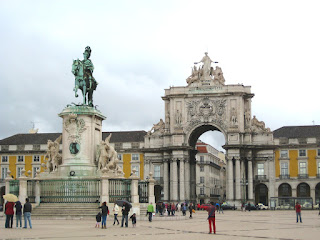Wednesday, April 20th. Ponta Delgada, The Azores.
Yesterday, we overheard three street-toughened women with Brooklyn accents discuss our next port of call.
“It's in Europe, isn't it?” asked one.
“They speak European.”
“Portuguese.”
“Whatever.”
Pause.
“It's lunchtime. I'm getting a hawt dawh-wug.”
“Okay. Have a good one.”
Ponta Delgada is on the volcanic island of Sao Miguel, the largest of nine that make up the autonomous region of the Azores. It's 900 nautical miles from Portugal, which discovered it in 1427. The area's total population is 237,000.
The city is not known for much of anything. Our normally chirpy ship's newsletter admits that the 16th Century religious paintings in its museum are by unknown artists, but are “nevertheless beautiful.” An on-line site states flat-out that the food is “generally poor, but squid can be good.”
 We wandered up a hill to a dramatic but somewhat decrepit church on the highest point of land. A dozen or more ancient trees stood guard around it, and the view was excellent. After, Bob bought a couple of bottles of wine to bring back to the ship, and we found a cafe with free internet. Bob uploaded the blog and answered some emails while we both enjoyed lattes (1 euro/each or $1.44/each!) The connection wasn't the fastest so we basically read our emails and only answered those that required immediate responses.
We wandered up a hill to a dramatic but somewhat decrepit church on the highest point of land. A dozen or more ancient trees stood guard around it, and the view was excellent. After, Bob bought a couple of bottles of wine to bring back to the ship, and we found a cafe with free internet. Bob uploaded the blog and answered some emails while we both enjoyed lattes (1 euro/each or $1.44/each!) The connection wasn't the fastest so we basically read our emails and only answered those that required immediate responses. If more people wrote us emails, we'd answer those too, especially when we get to our hotel in Barcelona a week from now. Take note Pam, David, Joe Jr., Cheryl, Margaret, Ellen, Karin . . . And thank you, Gary and Bob G, for keeping us up to date!
Friday, April 22nd. Lisbon. (Good Friday)
After another day at sea (April 21st), we sailed under Lisbon's version of the Golden Gate Bridge and arrived at a new dock around 2:00 pm. The new dock is east of the center of town (old dock is west) and none of our maps or the one the ship handed out showed this dock, but we could see St. George's Castle at the top of the hill. That, we thought, should be an easy stroll to acquaint us with the city.
The Alfama area beneath the castle is the oldest in the city, having survived the devastating earthquake of 1755. The problem is that its streets are like a tangle of yarn, some going straight up, some veering off to the left or right, and some disappearing altogether through a doorway with steps leading to who-knows-where? How invading armies ever found the castle at all is a mystery.
Houses in the area are also a jumble. You'd have to be born here to find your way home. Meanwhile, intermittent light drizzle began to turn into real rain, so instead of exploring further, we called it a day after two or three hours.
Saturday, April 23rd, Lisbon.
We took the metro from a station right across from the ship's dock up to the Calouste Gulbenkian Museum, established in 1955 by “one of the 20th Century's wealthiest men.” It's a small, modern building with what might best be described as an eclectic collection that includes ancient Egyptian and Greek coins, a mummy's mask, Islamic ceramics, oriental carpets and wall hangings, illustrated Medieval books, a della Robbia plaque, a sprinkling of medieval religious paintings, some sculptures by Houdon and Rodin, a few rooms of Louis XIV furniture and paintings, a Rembrandt, a Monet, a Cassett mother and child, a couple of early Turner seascapes, a Sargent portrait, a Gainsborough, some 18th Century silverware, and some odds and ends of art nouveau.
After this whirlwind tour of eastern and western art, we took the metro back to Restauraddores Station, which is in the Rossario section of the city. By then, the drizzle was getting heavier, and by the time we passed the Elevador Santa Justa with its long line of passengers waiting to get on, the rain began to come down in earnest.
Bob took a photo of the central walking street, Rue Augusta, in the Baxia (pronounced BAI sha) District, facing the Victoria Arch, filled with people carrying umbrellas. We stopped awhile under the awning of a shop, where Bob took another photo of wet tourists and locals. You can see how many of the streets are made from black and white small stones formed into dramatic patterns. Finally, as the shower let up, we continued on down to the city's central square, Praca do Comércio, on the waterfront, with its sculpture of someone on horseback.
This section of the city was well laid out after the great earthquake of 1755, and from there, it was a short walk back to the ship in time for a late lunch.
It is from this exact spot in the Praca do Comércio that Bob had his picture taken exactly 41 years ago to the month when he stopped here on a Northern European Cruise while in the US Navy. Sadly, this picture can no longer be found. (Whew!)
Today we are in Portimao, Portugal. The sun has come out and the computer battery is running low. Till later...









